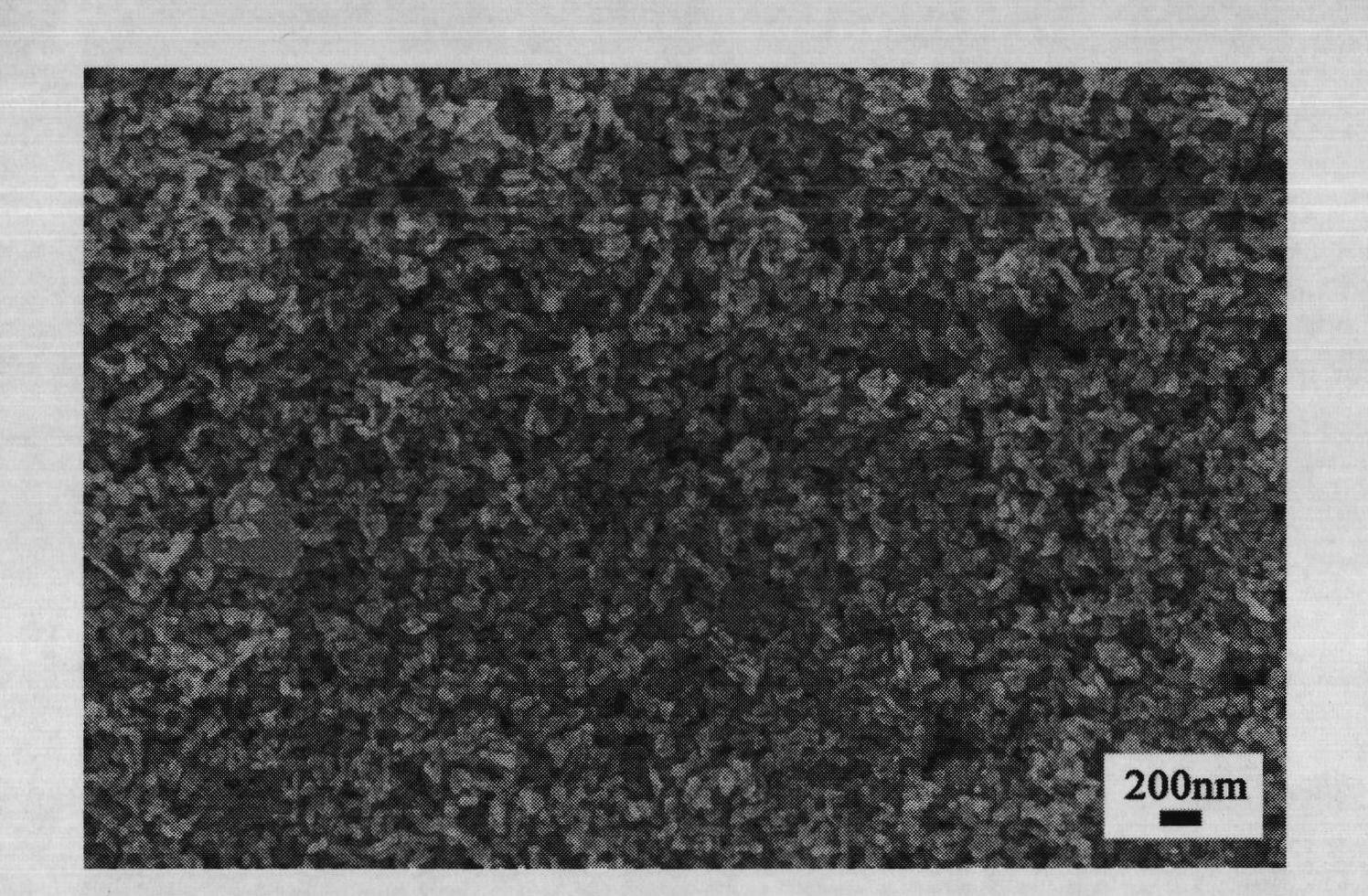Method for preparing SiO2-modified ZnO nano-porous thin film composite electrode
A composite electrode and nanoporous technology, applied in the field of nanomaterials, can solve the problems of continuous improvement of the conversion efficiency of dye-sensitized solar cells and other problems, and achieve the effects of improved sensitization performance, simple process, and improved acid corrosion resistance.
- Summary
- Abstract
- Description
- Claims
- Application Information
AI Technical Summary
Problems solved by technology
Method used
Image
Examples
example 1
[0022] 1. Fully grind the ZnO powder for 45 minutes, then heat-treat at 500 degrees Celsius for 45 minutes, and finally cool naturally to room temperature.
[0023] 2. The above treated ZnO powder (4g), terpineol (18mL), ethyl cellulose (2.0g) and alcohol (50mL) were mixed to prepare a slurry. Ultrasonic vibration and stirring were performed for 30 minutes. Then put it on the heating furnace to heat, and keep stirring for 20 to 30 minutes until a viscous slurry is formed.
[0024] 3. Evenly coat the ZnO nano-slurry on the FTO conductive glass, dry it and sinter it in a box furnace at 450°C for 1 hour, take it out after natural cooling, and you can get a ZnO nano-particle porous film electrode with a thickness of about 10 microns .
[0025] 4. Take a silica sol with a concentration of about 11-13 wt%, and ultrasonically treat it for 15 minutes to obtain a colloidal solution with an appropriate viscosity. Use a dropper to absorb the above-mentioned alumina sol and drop it on ...
example 2
[0028] 1. Fully grind the ZnO powder for 50 minutes, then heat-treat at 450 degrees Celsius for 30 minutes, and finally cool naturally to room temperature.
[0029] 2. The above-mentioned treated ZnO powder (2g), terpineol (9mL), ethyl cellulose (1.0g) and alcohol (50mL) were mixed to prepare a slurry. Ultrasonic vibration and stirring were performed for 30 minutes. Then put it on the heating furnace to heat, and keep stirring for 20 to 30 minutes until a viscous slurry is formed.
[0030] 3. Coat the ZnO nano-slurry uniformly on the aluminum sheet, dry it and sinter it in a box furnace at 450°C for 1 hour, take it out after natural cooling, and you can get a ZnO nano-particle porous film electrode with a thickness of about 10 microns.
[0031]4. Take a silica sol with a concentration of about 11-13 wt%, and ultrasonically treat it for 15 minutes to obtain a colloidal solution with an appropriate viscosity. Use a dropper to absorb the above-mentioned alumina sol and drop it ...
example 3
[0034] 1. Fully grind the ZnO powder for 40 minutes, then heat-treat at 450 degrees Celsius for 30 minutes, and finally cool naturally to room temperature.
[0035] 2. The above-mentioned treated ZnO powder (2g), terpineol (9mL), ethyl cellulose (1.5g) and alcohol (100mL) were mixed to prepare a slurry. Ultrasonic vibration and stirring were performed for 30 minutes. Then put it on the heating furnace to heat, and keep stirring for 20 to 30 minutes until a viscous slurry is formed.
[0036] 3. Coat the ZnO nano-slurry evenly on the stainless steel sheet, sinter in a box furnace at 450°C for 1 hour after drying, and take it out after natural cooling. Repeat coating twice to obtain a ZnO nanoparticle porous film electrode with a thickness of about 30 microns.
[0037] 4. Take a silica sol with a concentration of about 11-13 wt%, and ultrasonically treat it for 15 minutes to obtain a colloidal solution with an appropriate viscosity. Use a dropper to absorb the above-mentioned ...
PUM
| Property | Measurement | Unit |
|---|---|---|
| Thickness | aaaaa | aaaaa |
Abstract
Description
Claims
Application Information
 Login to View More
Login to View More - R&D Engineer
- R&D Manager
- IP Professional
- Industry Leading Data Capabilities
- Powerful AI technology
- Patent DNA Extraction
Browse by: Latest US Patents, China's latest patents, Technical Efficacy Thesaurus, Application Domain, Technology Topic, Popular Technical Reports.
© 2024 PatSnap. All rights reserved.Legal|Privacy policy|Modern Slavery Act Transparency Statement|Sitemap|About US| Contact US: help@patsnap.com










